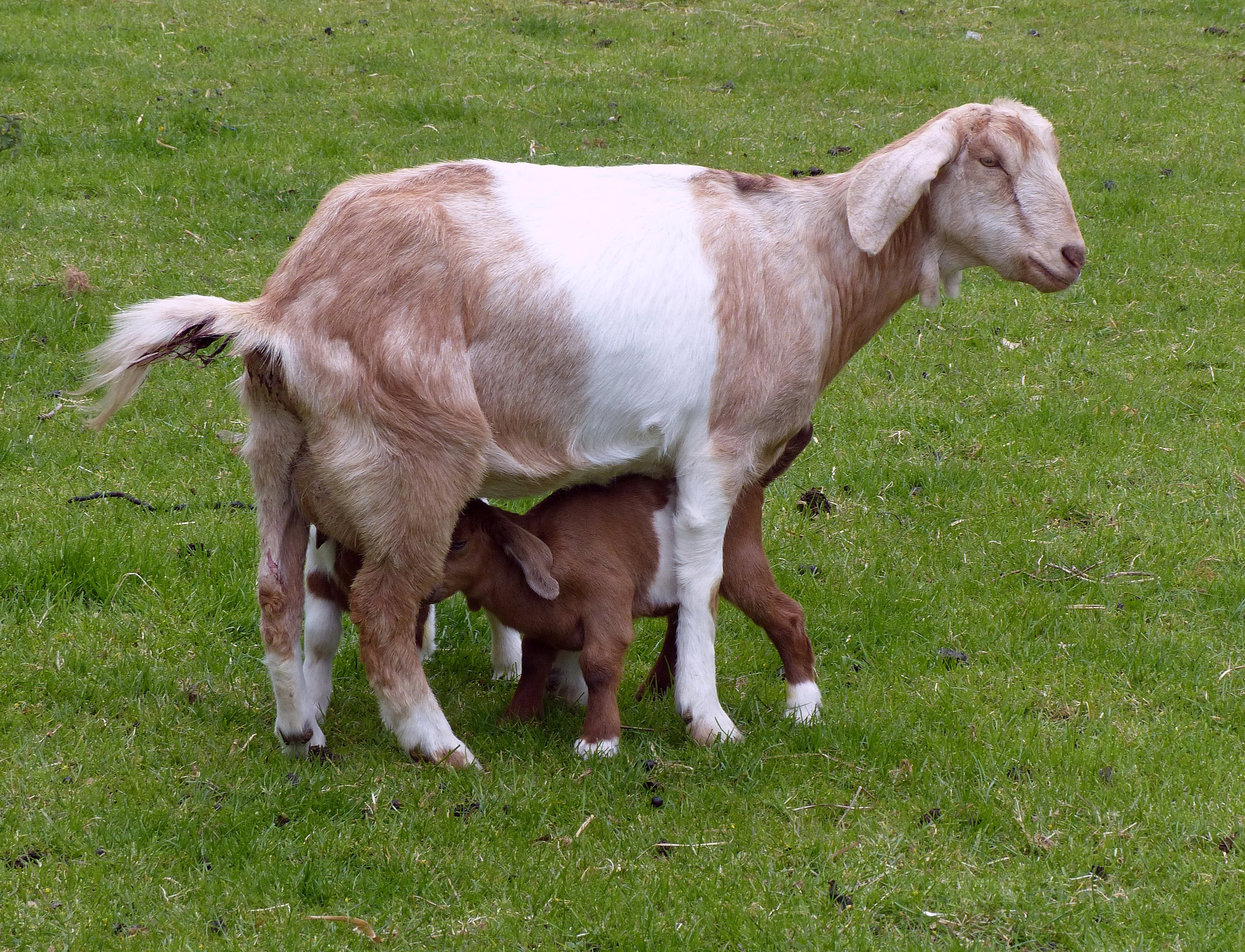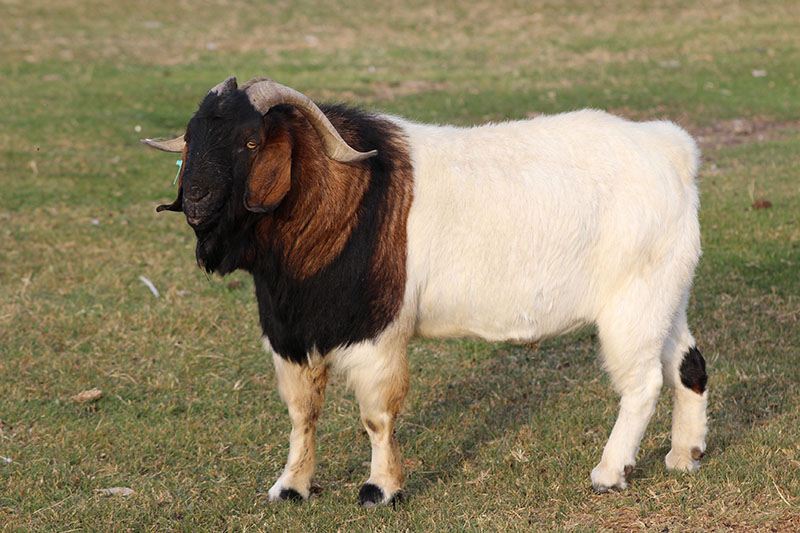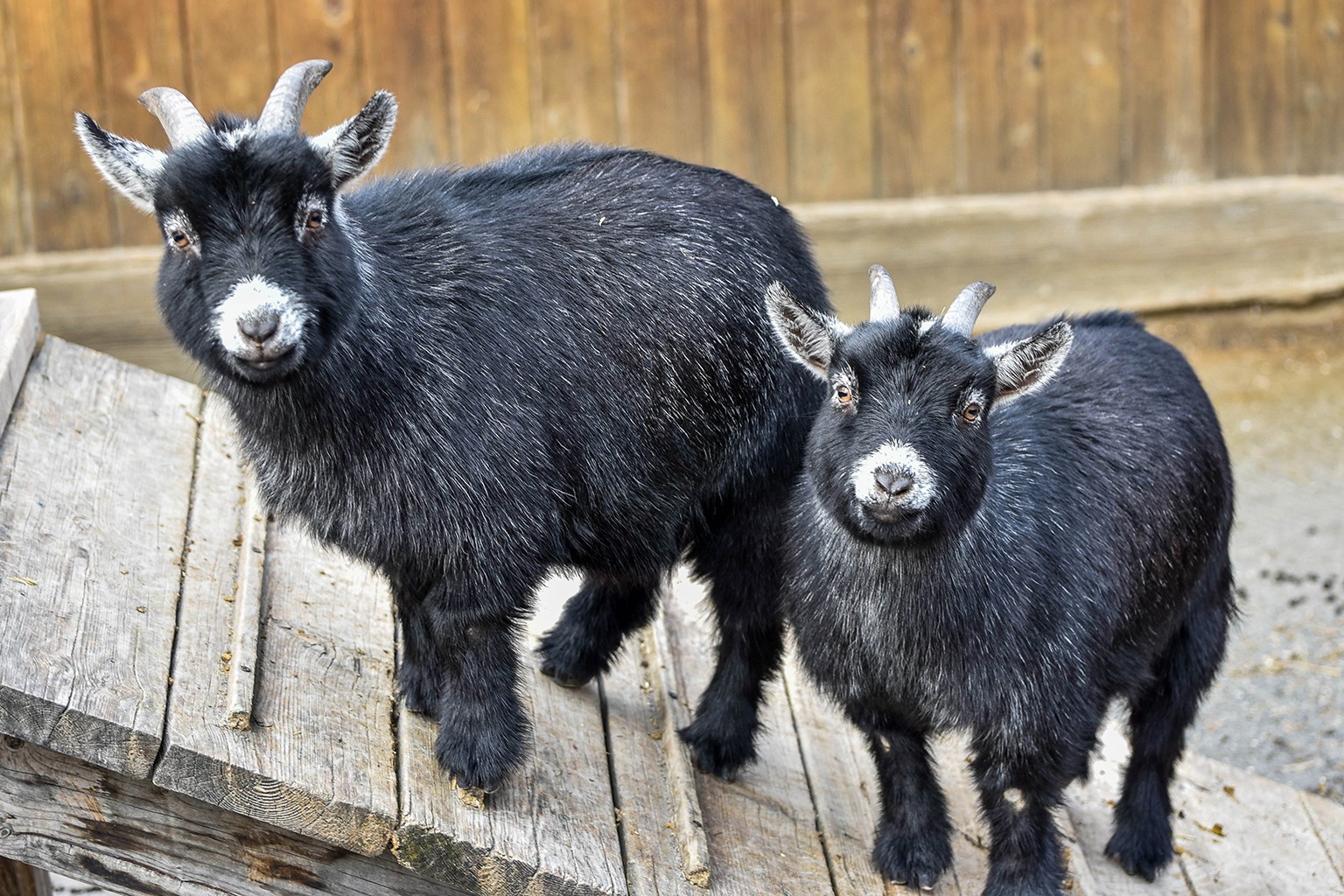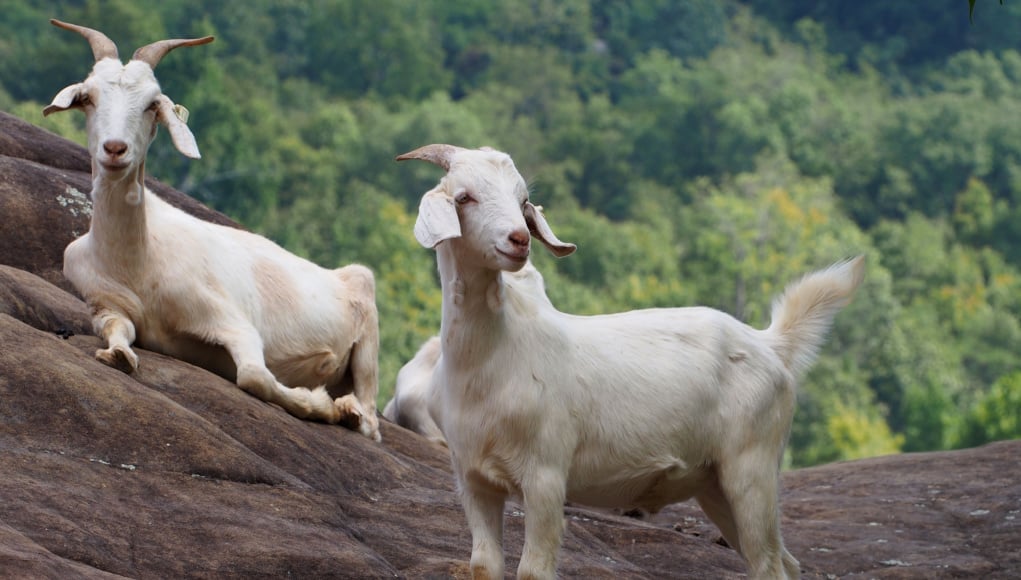Goats, the hooved ruminants belonging to the genus Capra in the family Bovidae, come in a remarkable variety of colors, sizes, and uses. With over 300 goat breeds existing worldwide, these versatile animals are raised for their hair fibers, dairy, meat, and even companionship. They are well-adapted to various natural and climatic conditions, making them valuable in different livestock systems.
In this article, we will explore 10 different types of goats from around the world, highlighting their unique characteristics and purposes.
You are reading: 10 Goat Breeds The Different Types Of Goats

10 Goat Breeds The Different Types Of Goats
Boer Goat

– Country of Origin: South Africa
– Distribution: International
– Use: Meat
– Weight: Adult females can grow up to 250 pounds, although most females weigh around 200 pounds
– Height: Varies
– Horn Status: Horned in both sexes
– Tassels: No
The Boer goat, also known as Boerbok, is a South African breed specifically developed for its meat qualities and ability to survive by grazing on the thorn veldt of the Eastern Cape region. It was created through selective breeding, with some infusion of European, Angora, and Indian goat bloodlines.
The breed’s success has led to its exportation to many countries, where it has been used to improve the meat qualities of other breeds.
Boer goats are characterized by their white bodies and distinctive brown heads, although some individuals can be completely brown or white, or “paint,” which means they have large spots of a different color. They have large pendulous ears and a red head and neck, with at least a portion of the neck being red.
One of the key features of the Boer goat is its impressive size, making it the largest goat breed in the world. Adult females can weigh up to 250 pounds, with most females averaging around 200 pounds. The breed’s rapid growth rate, excellent carcass qualities, and adaptability have contributed to its popularity for meat production.
American Pygmy Goat

– Country of Origin: United States
– Distribution: International
– Use: Companion, exhibition
– Weight: Varies
– Height: 1 to 2 feet
– Horn Status: Horned in both sexes
– Tassels: No
The American Pygmy goat, also known as the Pygmy or African Pygmy, is a small, compact, and stockily built breed that originated in the United States. It is distinct from the British Pygmy breed and shares its ancestry with the West African Dwarf group of breeds from Central and West Africa, particularly the Cameroon Valley.
The breed’s history can be traced back to the importation of small goats from German zoos to the United States between 1930 and 1960, which were initially used for exhibition or research purposes.
American Pygmy goats are highly valued as pet animals due to their miniature size, amiable and entertaining personalities, and adorable looks. They are docile, responsive, gregarious, friendly, good-natured, alert, animated, active, and fun-loving.
Male Pygmy goats have long, full beards, adding to their charming appearance.
In terms of size, American Pygmy goats reach a height of 1 to 2 feet, similar to the Nigerian Dwarf goat. Their weight can vary, but they are significantly smaller than most other goat breeds. They are primarily raised as companion animals and exhibition animals, and they are widely found in the United States and other countries.
Nigerian Dwarf Goat
– Country of Origin: Nigeria
– Distribution: International
– Use: Small-scale dairy production, companionship
– Weight: Ideal weight is around 75 pounds
– Height: Does: 17 to 19 inches, Bucks: 19 to 20 inches
– Horn Status: Horned or hornless
– Tassels: No
The Nigerian Dwarf goat is a miniature breed that originated in Nigeria and is part of the West African Dwarf group of breeds. Unlike the stocky West African Dwarf, the Nigerian Dwarf has been selectively bred to resemble a miniature dairy goat in appearance.
Its history can be traced back to the importation of small goats from West and Central Africa to the United States between the 1930s and 1960s, initially for exhibition purposes.
Nigerian Dwarf goats are known for their balanced conformation, with a straight nose, upright ears, and a soft coat of short to medium hair. They come in various colors and combinations, with silver agouti (roan) being considered a moderate fault. The breed’s small size and proportions are likely adaptations to their native climate and local preferences.
In terms of size, Nigerian Dwarf does reach a height of 17 to 19 inches, while bucks reach a height of 19 to 20 inches. Their weight is suggested to be around 75 pounds, based on HES evaluation information.
These goats are primarily raised for small-scale dairy production and companionship, and they have gained popularity as family pets due to their rich milk, small size, and easygoing nature.
Nigerian Dwarf goats can produce up to two quarts of milk per day, which has 10 percent more protein and butterfat than the milk of larger dairy goat breeds. They are also known for their docility, making them suitable for urban or small-scale farming environments.
Alpine Goat
– Country of Origin: France
– Distribution: International
– Use: Dairy, crossbreeding
– Weight: Mature does weigh around 135 pounds
– Height: About 30 inches at the shoulder
– Horn Status: Horned
– Tassels: No
The Alpine goat, also known as the French Alpine, is a medium to large-sized breed of domestic goat known for its excellent milking ability. It originated in the French Alps and has been widely used for commercial dairy production and as homestead milk goats. The breed is highly adaptable and has been successfully introduced to various climates and regions around the world.
Alpine goats have no set colors or markings, although certain markings are discriminated against. They can range from white or gray to brown and black, with various shades and combinations of these colors.
The breed’s adaptability and hardiness can be attributed to its origins in the Swiss Alps, where it adapted well to the rocky, dry landscape, extremes of temperature, and scarcity of vegetation.
In terms of size, mature Alpine does weigh around 135 pounds and stand about 30 inches tall at the shoulder. They have a straight profile, erect ears, and a medium-sized, fine-textured coat.
The breed is known for its heavy milk production, and the milk can be used to make butter, cheese, soap, ice cream, or any other dairy product normally made from cow’s milk.
Read more : Discover The Top 6 Rarest Tiger Species On The Planet
Alpine goats are horned in both sexes, and the males have a pronounced beard. They are often used for crossbreeding to improve the milk production of other goat breeds. The Alpine is a versatile and popular breed, valued for its milk production, adaptability, and hardiness.
La Mancha Goat
– Country of Origin: United States
– Distribution: International
– Use: Dairy
– Weight: Does weigh around 130 pounds, bucks weigh around 160 pounds
– Height: Does stand about 28 inches tall, bucks stand about 30 inches tall
– Horn Status: Horned and Polled
– Tassels: No
The La Mancha goat, also known as the American LaMancha, is a formally recognized breed of dairy goat that originated in the United States. The breed was first developed in California by Mrs. Eula Fay Frey around 1927 and later moved to Glide, Oregon for further development.
La Mancha goats are known for their high milk production, comparatively high butterfat content in their milk, and people-loving temperament.
One of the most distinctive features of La Mancha goats is their very short ear pinnae, which gives them an earless appearance. The breed’s lineage is uncertain, and its relation to goats from the La Mancha region of Spain is not proven.
However, it is believed that the breed descended from Spanish goats brought to California by early settlers. The short-eared American LaManchas gained recognition as a distinct breed in the early 1950s, and the breed was formally registered on January 27, 1958, as “LaMancha or American LaMancha” goats.
La Mancha goats come in various colors, including white, cream, shades of brown, gray, or black, with badger stripes, dairy markings, or pied patterns. They are medium-sized dairy goats, with does weighing around 130 pounds and bucks weighing around 160 pounds.
The breed has a straight face and two distinct ear types: “gopher ears” and “elf ears”. Only bucks with gopher ears are accepted for breeding, as bucks with elf ears may sire “throwback” kids with standard longer ears.
In terms of temperament, La Mancha goats are known for being friendly, calm, inquisitive, and lovable. They are easygoing and cooperative, making them a popular choice for dairy goat enthusiasts.
The breed is also known for its excellent dairy temperament and its ability to withstand a great deal of hardship while still producing quality milk with high butterfat and protein over a long period of time.
Nubian Goat
– Country of Origin: United Kingdom
– Distribution: International
– Use: Dual-purpose, meat, and dairy
– Weight: Does weigh at least 135 pounds
– Height: Varies
– Horn Status: Either polled or with small horns
– Tassels: No
The Nubian goat, also known as the Anglo-Nubian, is a British breed of domestic goat that originated in the nineteenth century from cross-breeding between native British goats and a mixed population of large lop-eared goats imported from India, the Middle East, and North Africa.
It is characterized by its large, pendulous ears and a strongly convex facial profile, often referred to as a “Roman nose”. The breed has been exported to more than sixty countries and is known for its dual-purpose use in meat and dairy production.
Nubian goats have a distinctive head, with wide, pendulous, and long ears that extend at least one inch beyond the muzzle when held flat along the face. The ears lie close to the head at the temple and flare slightly out and forward at the rounded tip, forming a bell shape. The breed’s hair is short, fine, and glossy, and the coloring is mostly reddish, often with spots or mottling patterns.
In terms of size, Nubian does weigh at least 135 pounds, and their height can vary. Unlike other dairy breeds, Nubians have been used in the goat meat production sector due to their larger size and meat quality.
They are known for their Middle-Eastern heritage, which allows them to thrive in hot climates and have a longer breeding season compared to other dairy goats.
Nubian goats are adaptable and have been successfully introduced to various regions around the world. They are either polled (without horns) or have small horns, and they do not have tassels, which are long, silky hairs on the neck or chest often seen in other goat breeds.
The breed’s combination of meat and dairy production, along with its unique appearance and adaptability, has made it a popular choice for goat enthusiasts worldwide.
Saanen Goat
– Country of Origin: Switzerland
– Distribution: Worldwide
– Use: Dairy
– Weight: 130 to 145 pounds
– Height: Medium to large
– Horn Status: Horned or hornless
– Tassels: No
The Saanen goat is a Swiss breed of domestic goat that takes its name from the Saanental in the Bernese Oberland, in the southern part of the Canton of Bern, in western Switzerland. It is a highly productive dairy goat and is distributed in more than eighty countries worldwide.
The breed originated in the Saanen Valley and is known for its white or light cream color, with white being preferred. Saanens have a short and fine coat, although a fringe over the spine and thighs is not unusual.
Saanen does are heavy milk producers, usually yielding 3-4 percent milk fat. They are medium to large in size, with rugged bone and plenty of vigor.
The breed is sensitive to excessive sunlight and performs best in cooler conditions, so the provision of shade is essential, and tan skin is preferable. Saanen goats are often referred to as “living marshmallows” due to their mild temperament, making them suitable as family companions and in showmanship classes.
Kiko Goat

– Country of Origin: New Zealand
– Distribution: International
– Use: Meat
– Weight: Does: 100 to 180 pounds, Bucks: 200 to 250 pounds
– Height: Does: 26 to 30 inches, Bucks: 30 to 37 inches
– Horn Status: Horned or polled
– Tassels: No specific mention in the search results
The Kiko goat is a breed of meat goat originating from New Zealand, with its name derived from the Māori word for meat. The breed was developed in the 1980s by Garrick and Anne Batten, who cross-bred local feral goats with imported dairy goat bucks of the Anglo-Nubian, Saanen, and Toggenburg breeds.
The primary aims of the breeding program were a fast rate of growth and the ability to survive in the pastoral conditions of the New Zealand hill country.
Kiko goats are known for their adaptability to various climates and environments, including subtropical, semi-arid, alpine, and temperate maritime regions.
They have a large size, with a beautiful coat that can be solid cream or white, sometimes with a shade of black. The breed is easy-going, active, and alert, while also being hardy, calm, gentle, and friendly in temperament.
Read more : 7 Types Of Ruminant Animals With Pictures
In terms of size, Kiko does typically weigh between 100 to 180 pounds, while bucks can reach 200 to 250 pounds. Their height ranges from 26 to 30 inches for does and 30 to 37 inches for bucks.
Kiko goats are primarily used for meat production and have gained popularity in the United States, where they were imported in 1992 by Goatex Group LLC. Today, there are three registries in the US for Kikos: the AKGA, the IKGA, and the NKR, with the latter being the largest of the three.
Tennessee Fainting (Myotonic) Goat
– Country of Origin: United States
– Distribution: International
– Use: Meat, pets, show
– Weight: Does: 50 to 80 pounds, Bucks: 60 to 100 pounds
– Height: Varies
– Horn Status: Horned or polled
– Tassels: No specific mention in the search results
The Tennessee Fainting Goat, also known as the Myotonic Goat, is an American breed characterized by myotonia congenita, a hereditary condition that may cause the goat to stiffen or fall over when excited or startled.
This breed may also be referred to as the Fainting Goat, Falling Goat, Stiff-Legged Goat, Nervous Goat, or Tennessee Wooden-Leg Goat. The origins of the breed can be traced back to four goats brought to Tennessee in the 1880s.
Tennessee Fainting Goats are medium-sized goats, with does weighing between 50 to 80 pounds and bucks weighing 60 to 100 pounds. They have a variety of coat colors and patterns, with a white body and black head being one example.
The breed is known for its unique myotonic condition, which causes temporary muscle stiffness or immobility when triggered by sudden movements or loud noises. Despite the name, these goats do not actually faint or lose consciousness when they fall over.
In terms of use, Tennessee Fainting Goats are primarily kept for meat production, but they are also popular as pets and in showmanship. They are adaptable to various climates and are known for their gentle and friendly temperament.
The breed’s myotonic condition has been of interest in scientific research, contributing to the understanding of muscle excitation and the role of chloride in muscle function.
Spanish Goat
– Country of Origin: Spain, United States
– Distribution: United States, Mexico, Caribbean Islands
– Use: Meat, brush-clearing
– Weight: 50 to 200 pounds
– Height: Varies
– Horn Status: Horned or polled
– Tassels: No specific mention in the search results
The Spanish goat, also known as the brush goat or scrub goat, originated in Spain and was brought to the United States via Mexico. It is a hardy breed that has adapted to thrive in various climates, making it suitable for meat production and brush-clearing purposes.
In the Southeast and other regions of the United States, they are often referred to as “wood,” “brush,” “briar,” “hill,” or “scrub” goats.
These goats were initially kept for clearing brush and other undesirable plant species from pasture lands, but their use for meat became significant as it allowed cattle to be reserved for draft power essential for crop production and transportation.
Spanish goats are known for their hardiness, adaptability, parasite resistance, and good mothering abilities. They are agile, friendly, and capable of eating a less desirable and more available diet than other sources of milk and meat.
The breed’s history dates back to the 16th century when Spanish explorers brought landrace goats from their native lands to the Caribbean Islands and areas that would later become the United States and Mexico.
While some landrace Spanish goats still exist in their native territory of Spain, the breed’s survival is through the bloodlines brought to the New World, adding to its genetic and historic importance.
Spanish goats are moderate in size and growth rate, with a wide range of colors and patterns. They are especially tolerant of difficult conditions and forage well on local plants.
Spanish does are prolific and produce enough milk for moderate growth rates of the kids. The breed is believed to be relatively tolerant of internal parasites, and its survival rate is good. However, availability of purebred stock may be limited due to their use in upgrading programs.
FAQS
1. What is the world’s largest goat breed?
The Boer goat is the world’s largest goat breed, originating from South Africa and known for its large meat production.
2. What is the world’s smallest goat breed?
The American Pygmy goat holds the title for the world’s smallest goat breed, often kept as pets due to their small size and friendly nature.
3. Which goat breed is best for pets?
The Nigerian Dwarf goat is a popular choice for a pet goat due to its small size, friendly temperament, and high milk production.
4. What is the Kiko goat breed known for?
The Kiko goat breed, developed in New Zealand, is known for its rapid kid growth, superb maternal nature, and improved carcass yield, making it a popular choice for meat production.
5. How did the Kiko goat breed originate?
The Kiko goat breed was developed in the 1980s by crossing feral goats with dairy goats in New Zealand, with a focus on survivability and growth rate.
6. What are the average height and weight of Kiko goats?
Kiko does have an average height of 26 to 30 inches, while bucks range from 30 to 37 inches. Does weigh between 100 to 180 pounds, and bucks can reach 200 to 250 pounds.
7. Which goat breed is suitable for various climates and environments?
The Kiko goat breed is well-adapted to a wide range of climates and environments, including subtropical, semi-arid, alpine, and temperate maritime regions, making them a versatile choice for different locations.
8. What is the primary purpose of the Kiko goat breed?
Kiko goats are primarily bred for meat production, thanks to their fast growth rate and high-quality carcasses.
9. Are there any unique crossbreeds of meat goats?
Some groups are working on developing new crossbreeds of meat goats, such as the TexMaster, which is a cross between Myotonic (Tennessee Fainting) goats or Tennessee Meat goats and Boer goats.
10. Which goat breed is known for its hardiness and adaptability?
The Spanish goat, also called the brush goat or scrub goat, is known for its hardiness and adaptability, making it suitable for various climates and terrains.
Source: https://petstutorial.com
Category: Animals










